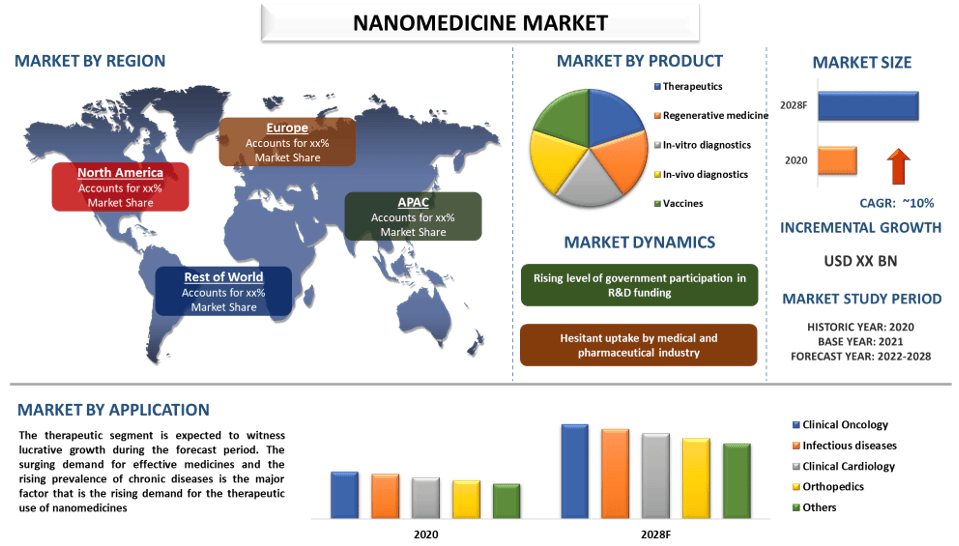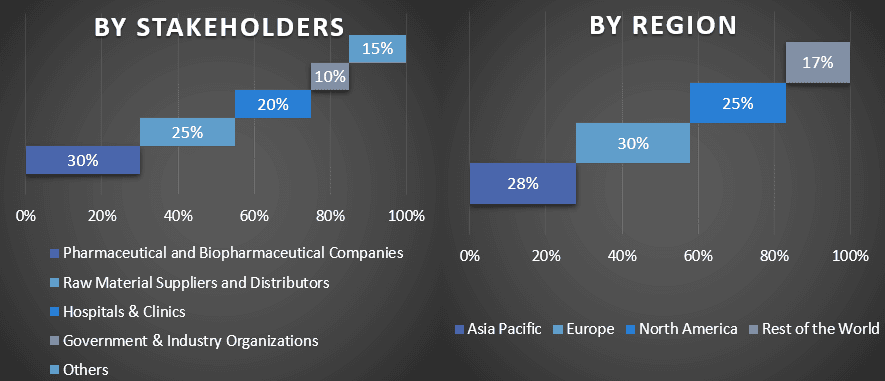- Home
- Chi siamo
- Settore
- Servizi
- Lettura
- Contattaci
Mercato della nanomedicina: Analisi attuale e previsioni (2022-2028)
Enfasi sul Prodotto (Terapeutici, Medicina Rigenerativa, Diagnostica In Vitro, Diagnostica In Vivo e Vaccini); Applicazione (Oncologia Clinica, Malattie Infettive, Cardiologia Clinica, Ortopedia e Altro); Regione (Nord America, Europa, Asia-Pacifico, Resto del Mondo); e Regione/Paese

Si prevede che il mercato globale della nanomedicina crescerà a un tasso significativo di circa il 10% durante il periodo di previsione. La nanomedicina è una branca della medicina che applica le conoscenze e gli strumenti della nanotecnologia alla prevenzione e al trattamento delle malattie. La nanomedicina prevede l'uso di materiali su nanoscala, come nanoparticelle biocompatibili e nanorobot, per la diagnosi, la somministrazione, il rilevamento o l'attuazione in un organismo vivente. La crescente incidenza di malattie croniche e l'attenzione allo sviluppo del campo dei nanovaccini contribuiscono in modo significativo alla crescita del mercato della nanomedicina. Inoltre, la crescente prevalenza di malattie croniche ha anche una quota significativa nella crescita del mercato della nanomedicina. Ad esempio, secondo l'OMS, circa 1,71 miliardi di persone in tutto il mondo soffrono di disturbi muscolo-scheletrici. Le condizioni muscolo-scheletriche sono la principale causa di disabilità a livello mondiale, con il mal di schiena che è la singola causa principale di disabilità in 160 paesi.
Arrowhead Pharmaceuticals Inc., Brigham and Women’s Hospital, Nanospectra Biosciences Inc., ABLYNX, AMAG Pharmaceuticals, Bio-Gate AG, Celgene Corporation, Johnson & Johnson Inc., Pfizer Inc. e Abbott sono alcuni dei principali attori del mercato. Diverse fusioni e acquisizioni insieme a partnership sono state intraprese da questi attori per facilitare i clienti con prodotti/tecnologie hi-tech e innovativi.
Approfondimenti presentati nel rapporto
"Tra i prodotti, la categoria Terapeutica registrerà un CAGR più elevato durante il periodo di previsione"
In base al prodotto, il mercato è segmentato in terapeutica, medicina rigenerativa, diagnostica in vitro, diagnostica in vivo e vaccini. La categoria terapeutica registrerà un CAGR più elevato durante il periodo di previsione a causa della crescente prevalenza delle malattie e dell'aumento dei casi di disturbi rari. Secondo il Genetic and Rare Diseases Information Center, ci sono circa 7.000 malattie rare conosciute e, collettivamente, circa 1 persona su 10 (o 30 milioni di persone) negli Stati Uniti ha una malattia rara.
"Tra le applicazioni, l'oncologia clinica deterrà una quota significativa del mercato nel 2021"
Sulla base dell'applicazione, il mercato è suddiviso in oncologia clinica, malattie infettive, cardiologia clinica, ortopedia e altro. Tra questi, l'oncologia clinica deterrà una quota significativa del mercato nel 2020. Il crescente numero di casi di cancro e la crescente domanda di trattamenti specifici per la malattia sono i fattori principali che aumentano la domanda di nanomedicina in oncologia clinica. Ad esempio, secondo l'OMS, il cancro è stata la principale causa di morte nel 2020 e i casi di cancro al seno e ai polmoni hanno rappresentato rispettivamente 2,26 milioni e 2,21 milioni.
"Il Nord America deterrà una quota significativa del mercato"
Nel 2020, il Nord America deteneva una quota significativa del mercato globale della nanomedicina. Ciò è principalmente attribuito al crescente numero di lanci di prodotti e ai crescenti investimenti nella ricerca sulla nanotecnologia nel settore sanitario nella regione. Ad esempio, a luglio 2021, Jazz Pharmaceuticals plc ha annunciato l'approvazione da parte di Health Canada e la disponibilità di Vyxeos® (daunorubicina e citarabina liposomiale per iniezione) per il trattamento di adulti con LMA correlata alla terapia (t-LMA) di nuova diagnosi o LMA con alterazioni correlate alla mielodisplasia (LMA-MRC). Inoltre, la crescente popolazione geriatrica nella regione è anche un fattore importante che aumenta le dimensioni del mercato della nanomedicina in Nord America.
Motivi per acquistare questo rapporto:
- Lo studio include analisi di dimensionamento e previsione del mercato convalidate da esperti del settore chiave autenticati.
- Il rapporto presenta una rapida panoramica delle prestazioni complessive del settore a colpo d'occhio.
- Il rapporto copre un'analisi approfondita dei principali concorrenti del settore con un focus primario sulle principali informazioni finanziarie aziendali, sul portafoglio prodotti, sulle strategie di espansione e sugli sviluppi recenti.
- Esame dettagliato dei fattori trainanti, dei vincoli, delle tendenze chiave e delle opportunità prevalenti nel settore.
- Lo studio copre in modo completo il mercato in diversi segmenti.
- Analisi approfondita a livello regionale del settore.
Opzioni di personalizzazione:
Il mercato globale della nanomedicina può essere ulteriormente personalizzato in base alle esigenze o a qualsiasi altro segmento di mercato. Inoltre, UMI comprende che potresti avere le tue esigenze aziendali, quindi sentiti libero di metterti in contatto con noi per ottenere un rapporto che si adatti completamente alle tue esigenze.
Indice
Metodologia di ricerca per l'analisi del mercato della nanomedicina (2022-2028)
L'analisi del mercato storico, la stima del mercato attuale e la previsione del mercato futuro del mercato globale della nanomedicina sono stati i tre passaggi principali intrapresi per creare e analizzare l'adozione della nanomedicina nelle principali regioni a livello globale. È stata condotta un'esaustiva ricerca secondaria per raccogliere i dati storici del mercato e stimare le dimensioni del mercato attuale. In secondo luogo, per convalidare queste intuizioni, sono stati presi in considerazione numerosi risultati e ipotesi. Inoltre, sono state condotte anche interviste primarie esaustive con esperti del settore lungo tutta la catena del valore del mercato globale della nanomedicina. Post-assunzione e convalida dei dati di mercato attraverso interviste primarie, abbiamo impiegato un approccio top-down/bottom-up per prevedere le dimensioni complete del mercato. Successivamente, sono stati adottati metodi di ripartizione del mercato e di triangolazione dei dati per stimare e analizzare le dimensioni del mercato dei segmenti e dei sottosegmenti del settore di riferimento. La metodologia dettagliata è spiegata di seguito:
Analisi delle dimensioni storiche del mercato
Fase 1: Studio approfondito delle fonti secondarie:
È stato condotto uno studio secondario dettagliato per ottenere le dimensioni storiche del mercato della nanomedicina attraverso fonti interne dell'azienda come relazioni annuali e bilanci, presentazioni sulle prestazioni, comunicati stampa, ecc., e fonti esterne tra cui riviste, notizie e articoli, pubblicazioni governative, pubblicazioni della concorrenza, rapporti di settore, database di terze parti e altre pubblicazioni credibili.
Fase 2: Segmentazione del mercato:
Dopo aver ottenuto le dimensioni storiche del mercato della nanomedicina, abbiamo condotto un'analisi secondaria dettagliata per raccogliere informazioni storiche sul mercato e condividere per diversi segmenti e sottosegmenti per le principali regioni. I segmenti principali inclusi nel rapporto sono prodotto e applicazione. Ulteriori analisi a livello di paese sono state condotte per valutare l'adozione complessiva dei modelli di test in quella regione.
Fase 3: Analisi dei fattori:
Dopo aver acquisito le dimensioni storiche del mercato di diversi segmenti e sottosegmenti, abbiamo condotto una dettagliata analisi dei fattori per stimare le dimensioni attuali del mercato della nanomedicina. Inoltre, abbiamo condotto un'analisi dei fattori utilizzando variabili dipendenti e indipendenti come vari prodotti e applicazioni della nanomedicina. È stata condotta un'analisi approfondita per gli scenari di domanda e offerta considerando le principali partnership, fusioni e acquisizioni, espansione aziendale e lanci di prodotti nel settore del mercato della nanomedicina in tutto il mondo.
Stima e previsione delle dimensioni attuali del mercato
Dimensionamento attuale del mercato: sulla base delle intuizioni utilizzabili dei 3 passaggi precedenti, siamo giunti alle dimensioni attuali del mercato, agli attori chiave nel mercato globale della nanomedicina e alle quote di mercato dei segmenti. Tutte le quote percentuali richieste e le ripartizioni del mercato sono state determinate utilizzando l'approccio secondario sopra menzionato e sono state verificate attraverso interviste primarie.
Stima e previsione: per la stima e la previsione del mercato, sono stati assegnati pesi a diversi fattori, tra cui driver e tendenze, vincoli e opportunità disponibili per le parti interessate. Dopo aver analizzato questi fattori, sono state applicate tecniche di previsione pertinenti, ovvero l'approccio top-down/bottom-up, per arrivare alla previsione di mercato per il 2028 per diversi segmenti e sottosegmenti nei principali mercati a livello globale. La metodologia di ricerca adottata per stimare le dimensioni del mercato comprende:
- Le dimensioni del mercato del settore, in termini di entrate (USD) e il tasso di adozione del mercato della nanomedicina nei principali mercati a livello nazionale
- Tutte le quote percentuali, le ripartizioni e le suddivisioni dei segmenti e dei sottosegmenti di mercato
- Attori chiave nel mercato globale della nanomedicina in termini di prodotti offerti. Inoltre, le strategie di crescita adottate da questi attori per competere nel mercato in rapida crescita
Convalida delle dimensioni e della quota di mercato
Ricerca primaria: sono state condotte interviste approfondite con i Key Opinion Leaders (KOL) tra cui Top Level Executives (CXO/VP, Sales Head, Marketing Head, Operational Head, Regional Head, Country Head, ecc.) nelle principali regioni. I risultati della ricerca primaria sono stati quindi riepilogati e sono state eseguite analisi statistiche per dimostrare l'ipotesi dichiarata. Gli input della ricerca primaria sono stati consolidati con i risultati secondari, trasformando così le informazioni in intuizioni fruibili.
Suddivisione dei partecipanti primari nelle diverse regioni

Ingegneria del mercato
La tecnica di triangolazione dei dati è stata impiegata per completare la stima complessiva del mercato e per arrivare a numeri statistici precisi per ogni segmento e sottosegmento del mercato globale della nanomedicina. I dati sono stati suddivisi in diversi segmenti e sottosegmenti dopo aver studiato vari parametri e tendenze nelle aree di prodotto e applicazione nel mercato globale della nanomedicina.
L'obiettivo principale dello studio sul mercato globale della nanomedicina
Le tendenze di mercato attuali e future del mercato globale della nanomedicina sono state individuate nello studio. Gli investitori possono ottenere informazioni strategiche per basare la loro discrezione sugli investimenti sull'analisi qualitativa e quantitativa eseguita nello studio. Le tendenze di mercato attuali e future hanno determinato l'attrattiva complessiva del mercato a livello regionale, fornendo una piattaforma per il partecipante industriale per sfruttare il mercato non sfruttato per beneficiare di un vantaggio di first-mover. Altri obiettivi quantitativi degli studi includono:
- Analizzare le dimensioni del mercato attuale e previsto del mercato della nanomedicina in termini di valore (USD). Inoltre, analizzare le dimensioni del mercato attuale e previsto di diversi segmenti e sottosegmenti
- I segmenti nello studio includono aree di prodotto e
- Definire e analizzare il quadro normativo per la nanomedicina
- Analizzare la catena del valore coinvolta con la presenza di vari intermediari, insieme all'analisi dei comportamenti dei clienti e dei concorrenti del settore.
- Analizzare le dimensioni del mercato attuale e previsto del mercato della nanomedicina per la regione principale.
- I principali paesi delle regioni studiati nel rapporto includono Asia Pacifico, Europa, Nord America e il resto del mondo.
- Profili aziendali del mercato della nanomedicina e le strategie di crescita adottate dagli operatori di mercato per sostenersi nel mercato in rapida crescita
- Analisi approfondita a livello regionale del settore
Correlati Report
I clienti che hanno acquistato questo articolo hanno acquistato anche










